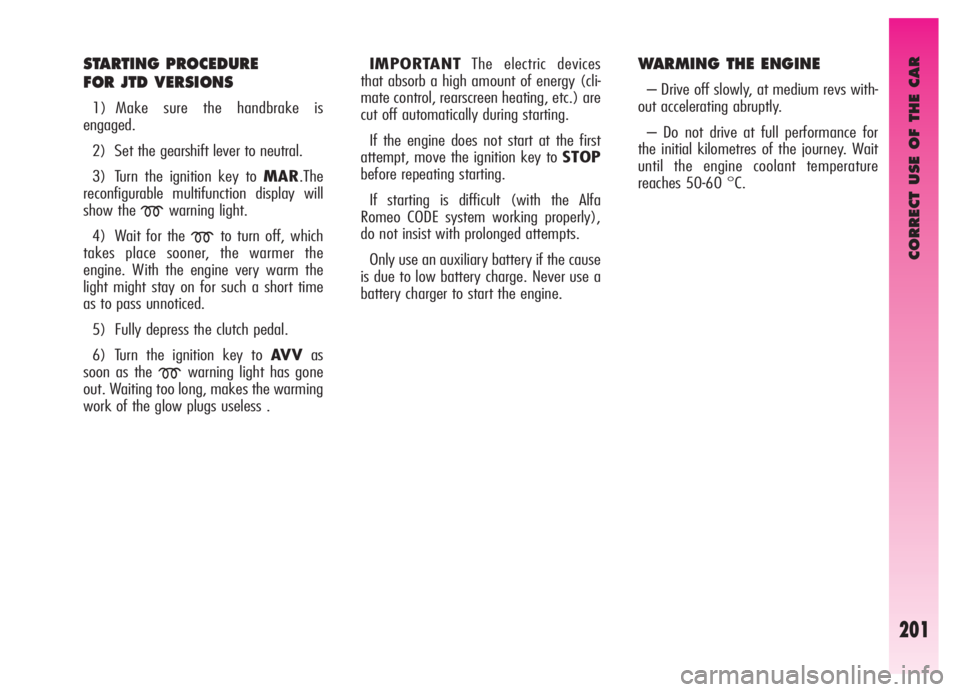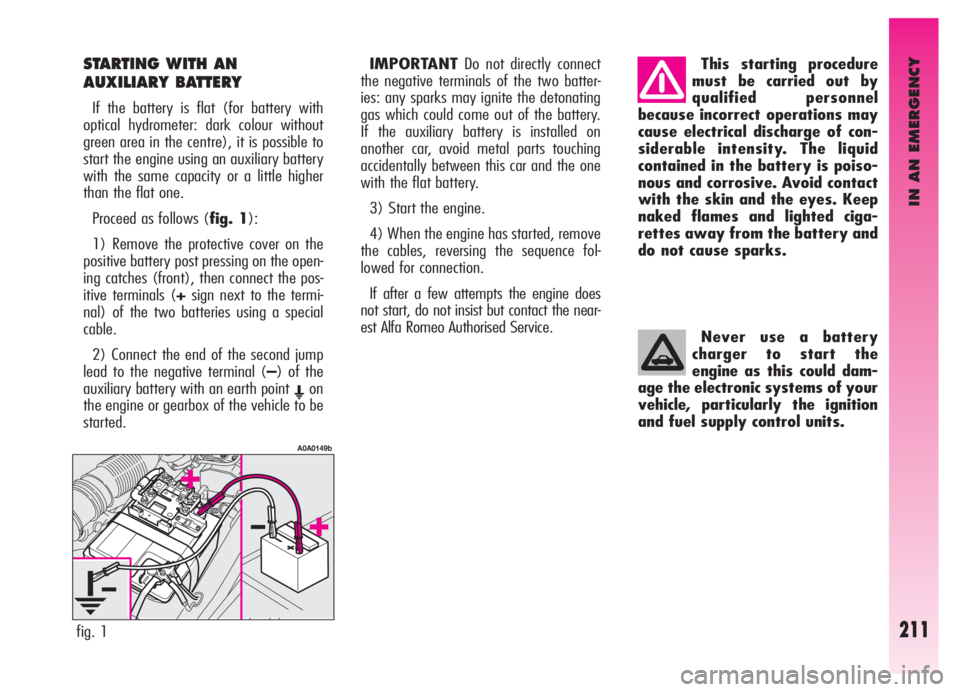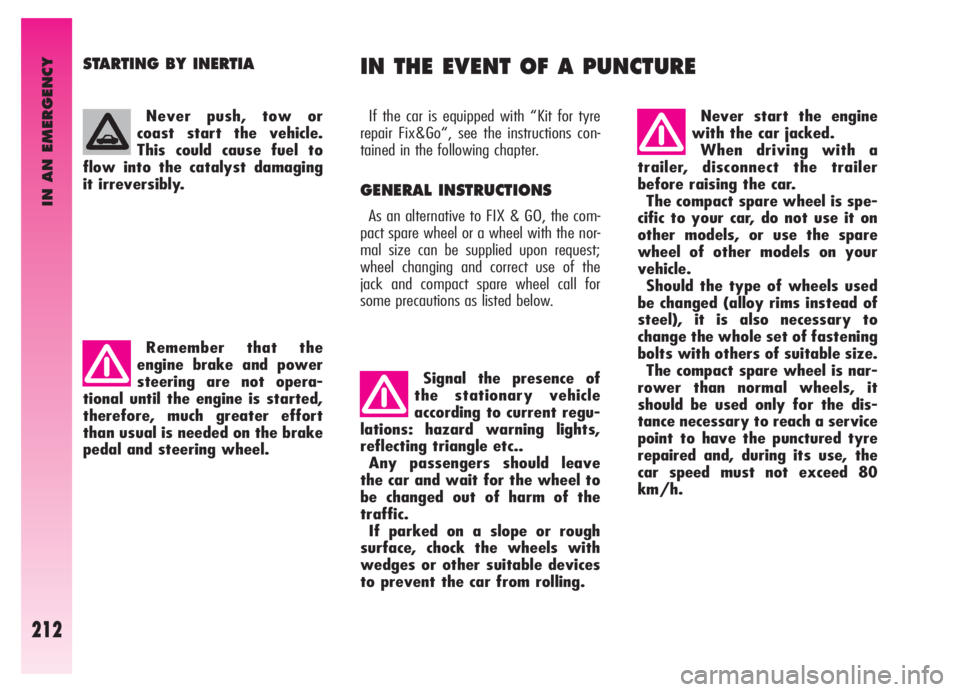engine Alfa Romeo GT 2006 Owner handbook (in English)
[x] Cancel search | Manufacturer: ALFA ROMEO, Model Year: 2006, Model line: GT, Model: Alfa Romeo GT 2006Pages: 307, PDF Size: 6.05 MB
Page 203 of 307

CORRECT USE OF THE CAR
201
STARTING PROCEDURE
FOR JTD VERSIONS
1) Make sure the handbrake is
engaged.
2) Set the gearshift lever to neutral.
3) Turn the ignition key to MAR.The
reconfigurable multifunction display will
show the
mwarning light.
4) Wait for the
mto turn off, which
takes place sooner, the warmer the
engine. With the engine very warm the
light might stay on for such a short time
as to pass unnoticed.
5) Fully depress the clutch pedal.
6) Turn the ignition key to AV Vas
soon as the
mwarning light has gone
out. Waiting too long, makes the warming
work of the glow plugs useless .IMPORTANTThe electric devices
that absorb a high amount of energy (cli-
mate control, rearscreen heating, etc.) are
cut off automatically during starting.
If the engine does not start at the first
attempt, move the ignition key to STOP
before repeating starting.
If starting is difficult (with the Alfa
Romeo CODE system working properly),
do not insist with prolonged attempts.
Only use an auxiliary battery if the cause
is due to low battery charge. Never use a
battery charger to start the engine.
WARMING THE ENGINE
– Drive off slowly, at medium revs with-
out accelerating abruptly.
– Do not drive at full performance for
the initial kilometres of the journey. Wait
until the engine coolant temperature
reaches 50-60 °C.
Page 204 of 307

Never push, tow or
coast start the vehicle.
This could cause fuel to
flow into the catalyst damaging
it irreversibly.
Remember that the
engine brake and power
steering are not opera-
tional until the engine is started,
therefore, much greater effort
than usual is needed on the brake
pedal and steering wheel.CORRECT USE OF THE CAR
202
For cars with tur-
bocharger in particular,
but for all cars in general,
sharp accelerating should be
avoided before switching the
engine off.
A “kick” on the accelerator
serves no purpose, consumes fuel
pointlessly and may cause seri-
ous damage to the turbocharger
impeller bearings.EMERGENCY STARTING
If the Alfa Romeo CODE system does not
recognise the code transmitted by the igni-
tion key (warning light
Yon the instru-
ment cluster glowing on steadily) emer-
gency starting may be carried out using
the code of the CODE card.
For the correct procedure see the chapter
“In an emergency”.
IMPORTANTIf the engine turns off
with the vehicle on the move, the next
time it is started, the Alfa Romeo CODE
warning light may turn on(
Y). In this
case, check that switching off and starting
the engine again with the vehicle station-
ary, the warning light stays off. If not, con-
tact Alfa Romeo Authorised Services.
ENGINE SWITCHING OFF
– Release the accelerator pedal and wait
until the engine reaches idle speed.
– Turn the ignition key to the STOP
position and switch off the engine.
IMPORTANTAfter a tiring journey it is
advisable to let the engine “get its breath
back” allowing it to idle a while to lower
the temperature in the engine compart-
ment.
Page 205 of 307

Never leave children
unattended in the vehicle.
Always remove the igni-
tion key when leaving the vehicle
and take it with you.To avoid useless con-
sumption of power and
possible draining of the
battery, never leave the ignition
key in the MAR position when
the engine is not running.
CORRECT USE OF THE CAR
203
PARKING
When the vehicle is parked, proceed as
follows:
– Switch off the engine.
– Engage the handbrake.
– Engage first gear if the vehicle is faced
uphill or reverse if the vehicle is facing
downhill.
– Turn the front wheels so that the vehi-
cle will immediately come to a halt if the
handbrake slips.
REDUCING RUNNING
COSTS AND
ENVIRONMENT
POLLUTION
By following a few simple guidelines, it
is possible to save vehicle running costs
and reduce harmful emissions.
GENERAL CONSIDERATIONS
Vehicle maintenance
To take care of the car maintenance
have the checks and adjustments carried
out in accordance with the “Scheduled
Maintenance Programme”.
Tyres
Check the pressure of the tyres routinely
at an interval of no more than 4 weeks: if
the pressure is too low consumption levels
increase as resistance to rolling is higher.
Useless loads
Never travel with an overload in the
boot. The weight of the vehicle (especial-
ly in urban traffic), and its geometry heav-
ily affect consumption levels and stability.Electric services
Use electric devices only for the amount
of time needed. Rearscreen heating, addi-
tional headlights, windscreen wipers and
heater fan need a considerable amount of
energy, therefore increasing the require-
ment of current increases fuel consump-
tion (up to +25% in the urban cycle).
Climate control system
The climate control system is a further
load bearing heavily on the engine induc-
ing higher consumption levels(up to
+20% on average). Outside temperature
permitting, preferably use the air vents.
Aerodynamic items
The use of non-certified aerodynamic
items may adversely affect air drag and
consumption levels.
Page 206 of 307

CORRECT USE OF THE CAR
204
CONDITIONS OF USE
Cold starting
Short journeys and frequent cold starts
do not allow the engine to reach optimum
operating temperature. This results in a
significant increase in consumption levels
(from +15 to +30% on the urban cycle)
and emission of harmful substances.
Traffic situations and road
conditions
Rather high consumption levels are tied
to situations with heavy traffic, for exam-
ple in queues with frequent use of the
lower gears or in cities with many traffic
lights. Also winding mounting roads and
rough road surfaces adversely affect con-
sumption.
Stopping in the traffic
During prolonged stops (e.g. level cross-
ings) it is advisable to switch the engine
off.
DRIVING STYLE
Starting
Do not warm the engine with the car at
a standstill or at idle or high speed: under
these conditions the engine warms up
much more slowly, increasing electrical
consumption and emissions. It is therefore
advisable to move off immediately, slow-
ly, avoiding high speeds. This way the
engine will warm faster.
Pointless manoeuvres
Avoid accelerating when waiting at traf-
fic lights or before switching off the
engine. This and also double declutching is
absolutely pointless on modern cars and
also increase consumption and pollution.
Gearshifting
As soon as the conditions of the traffic
and road allow, use a higher gear.
Using a low gear to obtain brilliant per-
formance increases consumption.
In the same way improper use of a high
gear increases consumption, emissions
and engine wear.Top speed
Fuel consumption considerably increases
with speed. Maintain an even as possible
speed, avoiding superfluous braking and
accelerating, which cost in terms of both
fuel and emissions.
Acceleration
Accelerating heavily taking the engine to
a high speed has a considerably adverse
effect on consumption and emission lev-
els; it is wise to accelerate gradually and
not exceed the maximum torque.
Page 211 of 307

CORRECT USE OF THE CAR
209
Keep your speed
down when snow
chains are fitted.
Do not exceed 50 km/h. Avoid
potholes, steps and pavements to
prevent damaging the tyres, sus-
pension and steering. Remember
that with snow chains fitted the
brake distance will increase.
VEHICLE INACTIVITY
If the vehicle is to be left inactive for
long periods, the following precautions
should be noted:
– House the vehicle under cover in a dry
and possibly ventilated place.
– Engage a gear.
– Check that the handbrake is not
engaged.
– Clean and protect the paintwork by
protective wax.
– Cover the rubber windscreen and
rearscreen wiper blades with talcum pow-
der and raise them off the glass.
– Open the windows slightly.
– Inflate the tyres to a pressure of 0.5
bars above normal. If possible rest the
tyres on wooden planks and periodically
check the pressure.
– Do not turn on the electronic alarm
system.– Disconnect the battery negative termi-
nal (–) from the battery and check the
battery charge. This check should be
repeated once a month during stowage.
Charge the battery if the loadless voltage
is below 12,5V.
– Do not empty the engine cooling sys-
tem.
– Cover the vehicle with a fabric or per-
forated plastic cover. Do not use compact
plastic covers which prevent the humidity
on the surface of the vehicle from evapo-
rating. Snow chains cannot be
fitted to the compact
spare wheel. So, if a front
(drive) wheel is punctured and
chains are needed, a rear wheel
should be fitted to the front of
the vehicle (inflate the tyres to
the specified pressure as soon as
possible) and the spare wheel
should be fitted to the rear. This
way, with two normal drive
wheels, snow chains can be fitted
to them to solve an emergency.
With snow chains fitted
it is advisable to turn off
the ASR system. Press
the ASR-OFF button, led on but-
ton on.
Page 212 of 307

IN AN EMERGENCY
210
3) Fully depress the accelerator pedal
and keep it pressed. The
Uwarning light
will come on for eight seconds and then
go off, now release the accelerator pedal.
4) The
Uwarning light begins to flash:
after it has flashed the same number of
times as the first digit on the CODE card,
press the accelerator pedal and keep it
pressed until the
Uwarning light turns
on (for four seconds) and then goes off;
now release the accelerator pedal.
5) The
Uwarning light starts to flash:
after the number of flashes corresponding
to the second digit on the CODE card,
press the accelerator pedal and keep it
pressed.
6) Repeat this procedure for the remain-
ing digits on the CODE card.
7) After entering the last figure, keep
the accelerator pedal pressed. The
U
warning light turns on (for four seconds)
and then goes off; now release the accel-
erator pedal.8) A quick flash of the
Uwarning light
(for about four seconds) confirms that the
operation has been carried out correctly.
9) Start the engine turning the ignition
key from MARtoAV Vwithout return-
ing the key to the STOPposition.
Conversely, if the
Uwarning light stays
on, turn the key to STOPand repeat the
procedure starting from point 1).
IMPORTANTAfter emergency starting
it is advisable to contact Alfa Romeo
Authorised Services, because the emer-
gency procedure must be repeated each
time the engine is started.
EMERGENCY
STARTING
If it is not possible to deactivate the
engine inhibitor with the Alfa Romeo
CODE system, the
YandUwarning
lights stay on and the engine will not
start. Emergency starting is needed to
start the engine.
IMPORTANTYou are advised to care-
fully read the entire procedure before car-
rying it out.
If a mistake is made during the emer-
gency procedure, the ignition key should
be turned to STOPand the operations
must be repeated from the start (point 1).
1) Read the 5-figure electronic code on
the CODE card.
2) Turn the ignition key to MAR.
I I
N N
A A
N N
E E
M M
E E
R R
G G
E E
N N
C C
Y Y
Page 213 of 307

IN AN EMERGENCY
211
STARTING WITH AN
AUXILIARY BATTERY
If the battery is flat (for battery with
optical hydrometer: dark colour without
green area in the centre), it is possible to
start the engine using an auxiliary battery
with the same capacity or a little higher
than the flat one.
Proceed as follows (fig. 1):
1) Remove the protective cover on the
positive battery post pressing on the open-
ing catches (front), then connect the pos-
itive terminals (+sign next to the termi-
nal) of the two batteries using a special
cable.
2) Connect the end of the second jump
lead to the negative terminal (–) of the
auxiliary battery with an earth point
Eon
the engine or gearbox of the vehicle to be
started.IMPORTANTDo not directly connect
the negative terminals of the two batter-
ies: any sparks may ignite the detonating
gas which could come out of the battery.
If the auxiliary battery is installed on
another car, avoid metal parts touching
accidentally between this car and the one
with the flat battery.
3) Start the engine.
4) When the engine has started, remove
the cables, reversing the sequence fol-
lowed for connection.
If after a few attempts the engine does
not start, do not insist but contact the near-
est Alfa Romeo Authorised Service.
fig. 1
A0A0149b
This starting procedure
must be carried out by
qualified personnel
because incorrect operations may
cause electrical discharge of con-
siderable intensity. The liquid
contained in the battery is poiso-
nous and corrosive. Avoid contact
with the skin and the eyes. Keep
naked flames and lighted ciga-
rettes away from the battery and
do not cause sparks.
Never use a battery
charger to start the
engine as this could dam-
age the electronic systems of your
vehicle, particularly the ignition
and fuel supply control units.
Page 214 of 307

IN AN EMERGENCY
212
STARTING BY INERTIA
If the car is equipped with “Kit for tyre
repair Fix&Go“, see the instructions con-
tained in the following chapter.
GENERAL INSTRUCTIONS
As an alternative to FIX & GO, the com-
pact spare wheel or a wheel with the nor-
mal size can be supplied upon request;
wheel changing and correct use of the
jack and compact spare wheel call for
some precautions as listed below.
IN THE EVENT OF A PUNCTURE
Never push, tow or
coast start the vehicle.
This could cause fuel to
flow into the catalyst damaging
it irreversibly.
Remember that the
engine brake and power
steering are not opera-
tional until the engine is started,
therefore, much greater effort
than usual is needed on the brake
pedal and steering wheel.
Signal the presence of
the stationary vehicle
according to current regu-
lations: hazard warning lights,
reflecting triangle etc..
Any passengers should leave
the car and wait for the wheel to
be changed out of harm of the
traffic.
If parked on a slope or rough
surface, chock the wheels with
wedges or other suitable devices
to prevent the car from rolling.
Never start the engine
with the car jacked.
When driving with a
trailer, disconnect the trailer
before raising the car.
The compact spare wheel is spe-
cific to your car, do not use it on
other models, or use the spare
wheel of other models on your
vehicle.
Should the type of wheels used
be changed (alloy rims instead of
steel), it is also necessary to
change the whole set of fastening
bolts with others of suitable size.
The compact spare wheel is nar-
rower than normal wheels, it
should be used only for the dis-
tance necessary to reach a service
point to have the punctured tyre
repaired and, during its use, the
car speed must not exceed 80
km/h.
Page 216 of 307

IN AN EMERGENCY
214
CHANGING A WHEEL
Please be informed that:
– the jack mass is 2,100 kg.
– the jack requires no adjustment.
– the jack cannot be repaired. In the
event of breakage, it must be replaced by
another original one.
– no tools other than its operating crank
can be fitted to the jack.
To change a wheel, proceed as follows:– Stop the car in such a position that it
is not dangerous for the traffic, where it is
possible to change the wheel safely.
Where possible, park on a level, compact
surface.
– Switch off the engine and engage the
handbrake.
– Engage first gear or reverse.– Use handle(A-fig.2) to remove the
stiff covering (B).
– Loosen the clamping device (A-
fig. 3).
– Take out the tool container (B) and
take it near the wheel to be changed.
– Take the spare wheel (C).
– Remove the wheel cap (A-fig. 4)
(only versions with steel rims)
fig. 2
A0A0645b
fig. 3
A0A0151b
fig. 4
A0A0154b
Page 222 of 307

IN AN EMERGENCY
220
– make sure the compressor switchA-
fig. 16is set to 0 (off), start the engine
and fit plugA-fig. 17into the outlet/cig-
ar lighter on the front console and then turn
on the compressor by setting switch A-fig.
16toI(on);– inflate the tyre to the proper pressure
value. Check tyre pressure on gauge B-fig.
16with compressor off to obtain precise
reading;
– if after 5 minutes it is still impossible
to reach at least 1.5 bar, disengage com-
pressor from valve and current outlet, then
move the car forth for approx. 10 metres in
order to distribute the sealing fluid inside the
tyre evenly, then repeat the inflation oper-
ation;– if after this operation it is still impossi-
ble after 5 minutes to reach at least 1.8 bar,
do start driving since the tyre is excessive-
ly damaged and the quick tyre repair kit can-
not guarantee suitable sealing, contact Al-
fa Romeo Authorized Services;
– after reaching the proper tyre pressure,
start driving immediately;
Apply the sticker in a vis-
ible position for the driver
to indicate that the tyre
has been treated with the quick
tyre repair kit. Drive carefully es-
pecially when cornering and do not
exceed 80 km/h. Avoid heavy
braking and accelerating.
fig. 16
A0A1100b
fig. 17
A0A0647b